Author's Note: The the second part of a multi-part retrospective on Final Fantasy VI, If you missed the first part here's the link:
- Finishing Final Fantasy VI - Episode 1: Is This The Greatest Video Game Introduction?
- Finishing Final Fantasy VI - Episode 2: Hot Take Time: The Opera House Scene Is Very Good (But Setzer Sucks)
If you enjoyed this episode, here's a directory to the first episodes of every Final Fantasy game I have covered on this site thus far:
- Part 1 of Final Fantasy I series
- Part 1 of Final Fantasy II series
- Part 1 of Final Fantasy V series
- Part 1 of Final Fantasy VII series
- Part 1 of Final Fantasy VIII series
- Part 1 of Final Fantasy IX series
- Part 1 of Final Fantasy X series
- Part 1 of Final Fantasy X-2 series
- Part 1 of Final Fantasy XI series
- Part 1 of Final Fantasy XII series
- Part 1 of Final Fantasy XIII series
- Part 1 of Final Fantasy XIII-2 series
Part 11: Thamasa Is The Last Time This Game Is Deliberately Funny
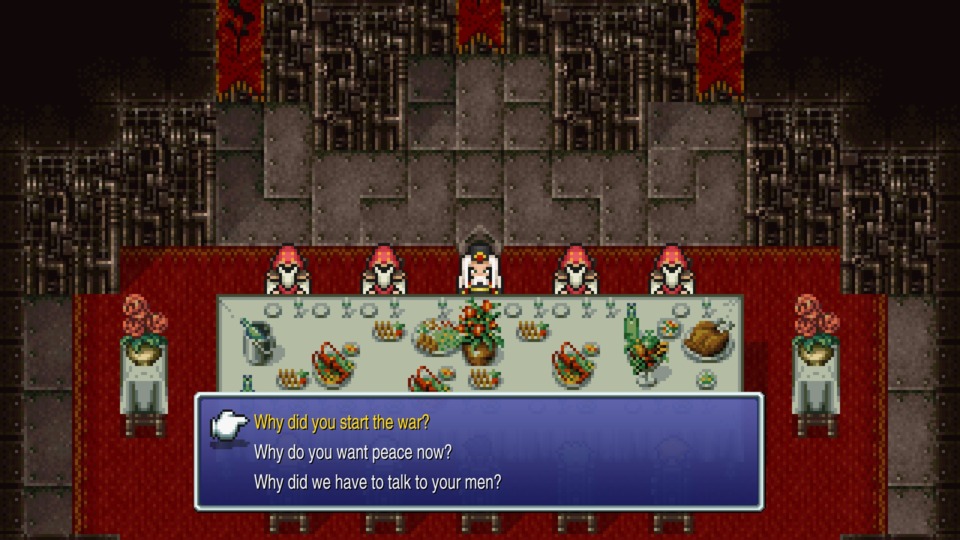
This blog's three big talking points are exactly what the title suggests. Today I'm going to review the game's "big twist," introduction of the World of Ruin, and its cavalcade of character recruitment-focused side quests. However, there's plenty to discuss before and in between that trifecta. For example, after you wrap up the events surrounding the Sealed Gate, there's a poignant and solemn moment at Vector with the Emperor. In the previous two episodes of this retrospective, I have mentioned how much I enjoy how the game breaks up the usual town-dungeon-boss formula with interstitial set pieces. The Opera House scene is the ultimate example, but plenty of others do as good a job mixing things up in the game. The dinner table scene with Vector's Emperor is no slouch, given that it plays into the story's gut-wrenching "big con." In this case, after the Espers break from their realm and enter the world of humanity, they unleash an onslaught of destruction that torches Vector and leaves other surrounding towns in ruins. When the Returners approach the Emperor, he swears that his wars of conquest are over and will assist in alleviating the Esper threat. However, your interaction with him is a diplomatic game of chess wherein your dialogue prompts must press the Emperor to admit his wrongs without putting all of the blame on him and his fellow citizens. There's a shocking amount of nuance with each choice you make, and the best answers are not immediately apparent, which threw me for a loop because I felt like the dialogue prompts were harder to weigh and assess than most modern BioWare or Bethesda games.
This point of order leads us to the journey to Thamasa and the mysterious village we encounter there. Before you reach Thamasa, it's important to note how much the game wants you to believe you are nearing the end. Having played I, II, IV, and V before VI, I knew the game had something up its sleeve. Nonetheless, when General Leto nobly speaks of the mission to Thamasa as the "end of the road," there's no denying that you want him to be correct. Through your interactions with him and your scavenger hunt at Vector (i.e., the part where the Emperor asks you to talk to twenty soldiers), you begin to accept the game's message that the everyday soldiers on both sides of this specific conflict are not so different. Now, I want to make a bit of a hard stop and say that Final Fantasy VI is not the first game, nor is it the last, in this series that has this message. Final Fantasy IX and General Beatrix's redemption arc come to mind first when I think about this topic. I want to say that modern Japanese writers conveniently love this idea and sneak it into a ton of anime, manga, and video game stories. However, I find it to be a wicked cop-out. It tells the audience that individual soldiers are pathetic and have no agency in their actions as they are accountable to orders from a higher power. Not only that, but we should judge these soldiers by the weight of their hearts, and if they did something heinous at a time of war, then golly, we can't blame them because they couldn't help it! All I will say is fuck that shit! Fuck that shit straight to the fucking sun. Also, I should note that I took the time to recruit Mog, and I like Mog, thanks to their high HP. Nonetheless, the actual use for Mog comes during the World of Ruin and when you can equip them with the Moogle Charm.
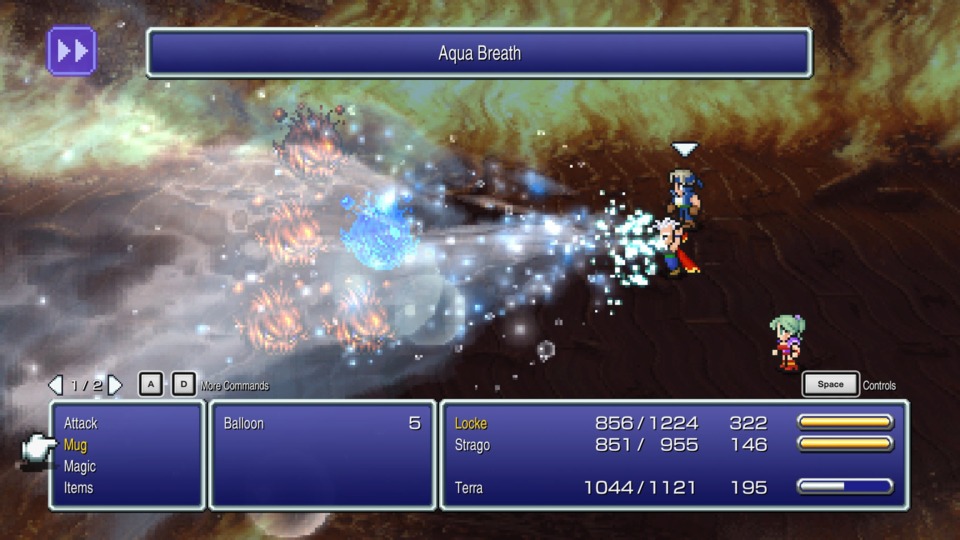
Nevertheless, there's no denying how quaint and pleasurable the quest at Thamasa is on paper. Leto has a touching interplay with Terra about coming to terms with one's emotions and falling in love. There's the brief hint that the two have a potential subplot in the future, and when the game rips that hope away from you, it does a magnificent job of further hammering home the nefarious nature of Kefka. I also want to mention how fearful I was that Terra would spend the entire game as a pseudo-robot that everyone needs to teach emotions, and I was pleasantly surprised when I discovered that not to be the case. Once you reach Thamasa, I have to be honest; the game insisting that the villagers being mages is a mystery annoyed me. Watching the characters see kids throw fireballs and not know what was up makes them seem like complete dumbasses. However, eventually, the game stops fucking about and begins to punch its weight when we learn that a girl named Relm is stuck in a burning building. With the assistance of her grandfather, Strago, you make your way to Relm and pull her out in the nick of time. Many of you might point out how rescuing children or family members from a burning building is a recurring trope in the Final Fantasy franchise. I think a little bit of context in this matter is necessary. While working on Final Fantasy III, Hironobu Sakaguchi learned that a fire had broken out in his childhood home. When he arrived at the scene, the house had burned to the ground, and his mother had died. That tragedy informed his outlook for the better part of a decade, with fire and flames engulfing the most tragic and devastating moments in the series until he left Square. Final Fantasy VII's "Nibelheim Incident" is the most prominent example of Sakaguchi's grief bleeding into his work.
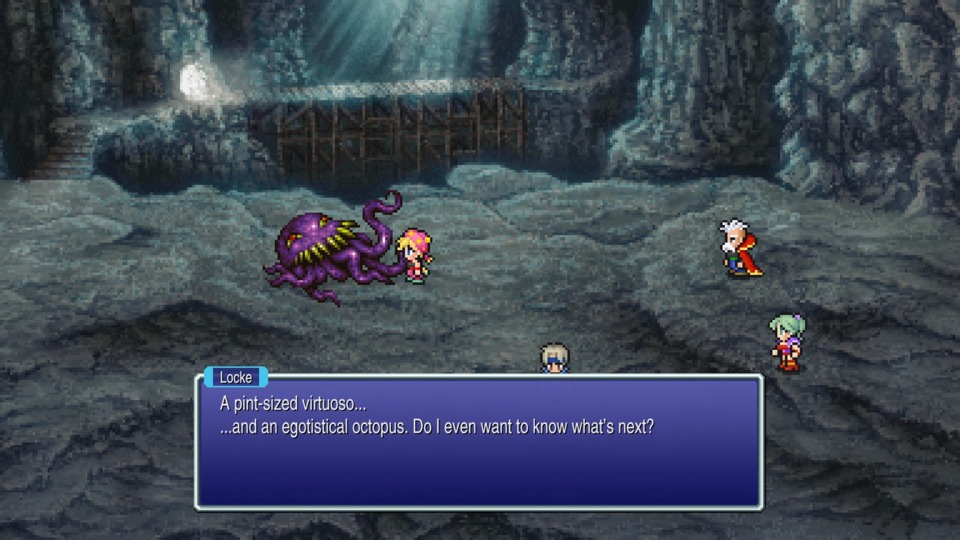
And yet, Thamasa is defined very much with an undercurrent of comedy. The back-and-forth dialogue between Strago and Relm is a manzai comedy act, with Relm and Stargo exemplifying the boke and tsukkomi archetypes, but luckily without any physicality. This story beat continues into the Esper Cave, where you battle Ultros. This boss encounter is honestly the last time the game attempts at comedy within the scope of the mainline story. From this point forward, the characters need to earn their rays of hope. For those who played the game on the SNES, you may recall a nasty bug where the game locks up and erases your save data if you attempt to use Relm's Sketch ability. That's not the case in the Pixel Remaster, but I don't use Sketch outside this battle. Most enemies either are immune to the elemental or status effect-inflicting moves you reflect on to them, and "Control" is such a vastly superior alternative. Then, when it comes to Strago, he's introduced far too late for me to give a fuck about his Blue Mage gameplay hooks, especially after I took the time to make Gau a murder machine. It was nice he started with a water-based attack to make things easier in the burning building, but the rest of his starting abilities are weak.
Part 12: The Big "Twist" Isn't That Big In Hindsight, But It's Still Good!
However, the game's light-hearted nature comes to a quick and brutal end. Though General Leto manages to parley with the Espers and convinces them that there is a peaceful solution to their current conflict, Kefka arrives to ruin the scene. The clown begins massacring the Espers to turn them into Magicite and even has a company of soldiers to support him. Leto is horrified and attempts to stop Kefka by battling him in a one-on-one confrontation. However, Kefka gets the better of him through trickery and murders him. With a treasure trove of Magicite and Leto out of the picture, Kefka departs after summoning the Floating Continent. The party learns that the Floating Continent is the island on which the Cave to the Sealed Gate was residing and contains the "Warring Triads," three statues holding three powerful gods that keep the world in balance. Again, the story wants you to believe this is the end of the game. My hindsight did not allow me to buy that for a minute, even during my first playthrough. Even then, the Floating Continent is one of the game's most prominent "points of no return." If you have any business to attend to on the World of Balance, now's the time. If there is one niggling nitpick, I think locking Mog's Water Dance exclusively to the World of Balance is a dick move.
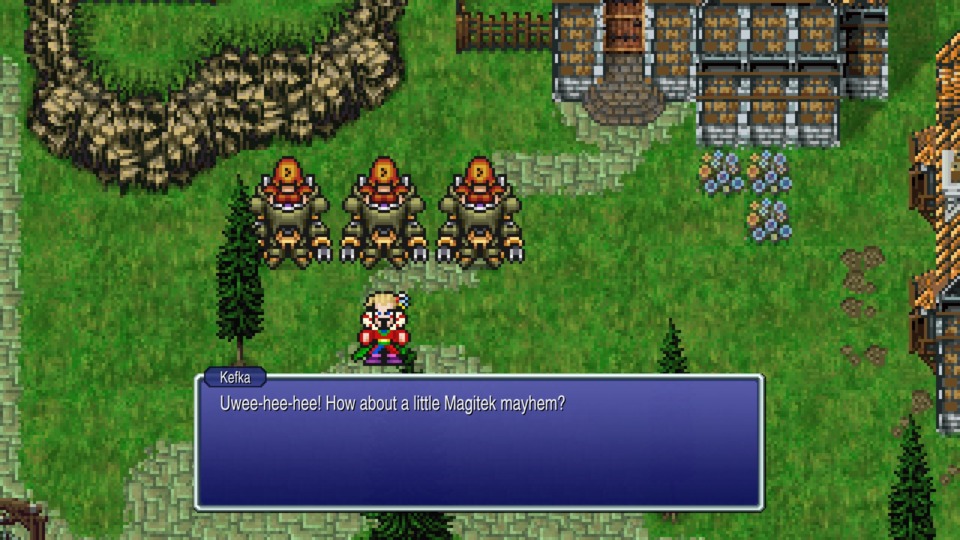
Before we discuss the fantastic storytelling on the Floating Continent, we need to talk about it in some capacity as a level. I understand why the Floating Continent is the most challenging level you have encountered up to this point. However, I think the design team went a little too hard. First, the random encounter rate is INSANE. There were times when I felt like I took three to four steps in between random encounters. The frequency of those battles makes the second issue of the level even worse. That problem involves not knowing where you need to go or what to do to trigger the next boss battle and ensuing cutscene. Some like the Giger-inspired biomechanical look of the Floating Continent, but it has one massive drawback. Its monochromatic color palette makes it difficult to parse what the interactable elements might be. I cannot begin to list the number of times I missed a switch because I misunderstood it as an ancillary background texture. And it isn't easy. The enemies you encounter at the Floating Continent don't just hit hard, but a large portion of them inflict a myriad of status effects that can be a chore to cure. I understand the designers did this on purpose as a "gear check" for the player. However, nothing leading up to the Floating Continent even remotely prepares you for what you deal with there.
However, who honestly gives a shit about Platinum Dragons and Behemoths? If we are going to talk about the Floating Continent, then we need to talk about the story. Whenever the topic of the Floating Continent comes up in Final Fantasy fandom circles, two discussion points usually crop up. First are those that relay how shocked they were to discover Kefa was the main antagonist. Second are the people who present the plot twist involving Kefka defeating the heroes and bringing forth the World of Ruin as a massive risk the likes of which the franchise had never seen. I appreciate the spirit of these mindsets but disagree with them violently. Final Fantasy I features an ass pull twist boss that comes out of nowhere. While Kefka is narratively more interesting than Garland and Chaos, there's no denying that every Final Fantasy game since the first one has been refining and perfecting this plot device. Also, I don't buy the premise that it is surprising Kefka is the ultimate bad guy in the story. Even if you disregard hindsight and that he's a mascot for Final Fantasy VI, Kefka is a larger-than-life character that you know is up to something.
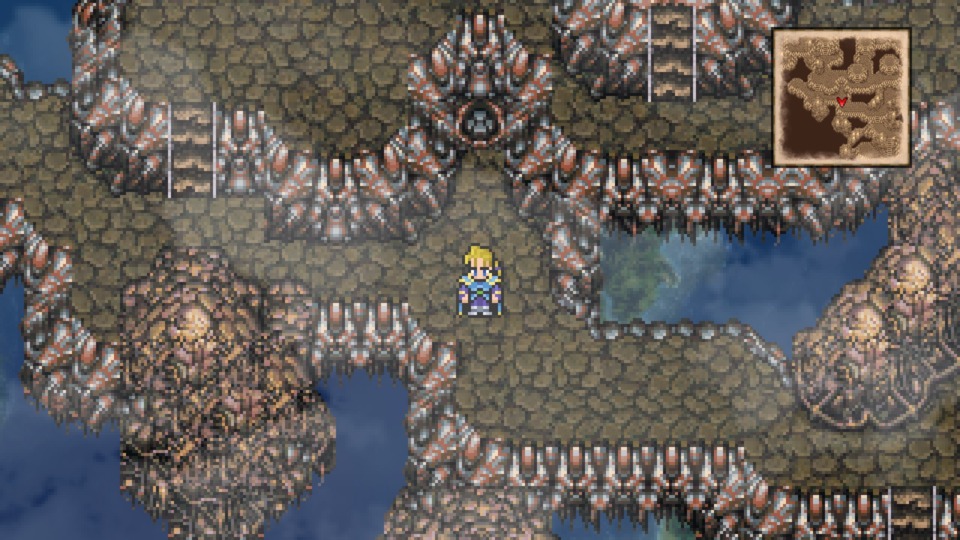
Regarding the World of Ruin being a shocker, I have to check my privilege of playing previous games in the series before completing this one. Final Fantasy VI was a gateway game for a massive number of people. To those who got their start playing RPGs, thanks to it, this revelation sticks out as a daring and beautiful masterpiece. Also, a significant amount of gall is needed to make players of a video game wade in their failure as thoroughly as Final Fantasy VI does. The sense of loss and disappointment the characters convey persists longer than you think. While some, like Sabin or Gau, rejoin your party enthusiastically and answer the call to adventure without missing a beat, other characters like Locke, Cyan, and Terra require more work. Part of me almost wishes that there was at least one member of your party that entirely refuses the second call to adventure to hammer home the characters being at their lowest point. Nevertheless, the game wants to show you the value of perseverance and provides every character with at least some form of emotional or psychological release. All of that is only possible if Kefka is allowed to blow up the world, and the writers had great foresight in recognizing that.
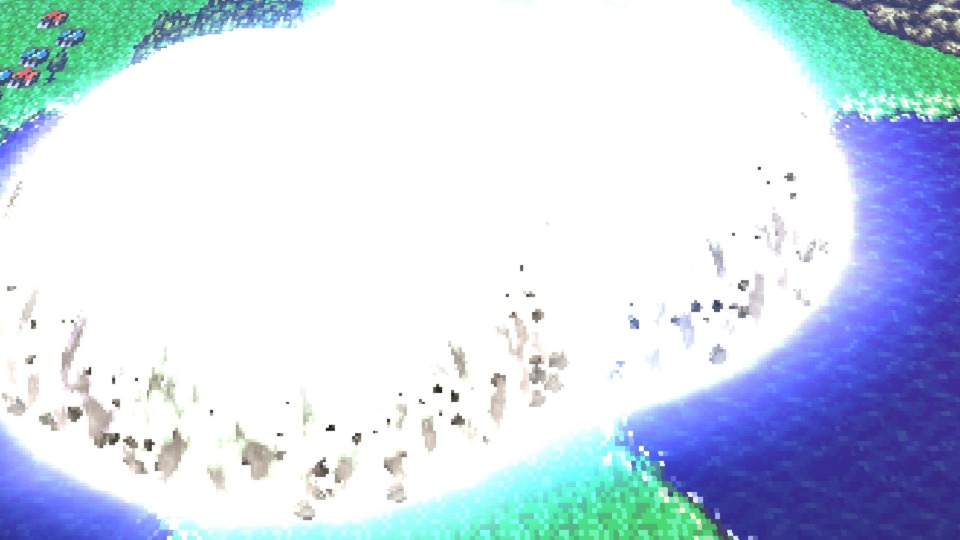
Yet, I think it is essential to recognize Final Fantasy VI not as the Ur-example of genre and series standards but as the final 2D torch-bearer and the narrative codifier for the future of the series. I remember the characters of Final Fantasy IV fucking up so bad that they needed to play makeup for two hours and chase after the big bad to the moon. I also remember the characters of Final Fantasy V losing an entire party member while allowing an evil tree man to smash two dimensions together. The Final Fantasy games, for much of their history, are about a series of self-contained narratives that share a collection of storytelling and mechanical traditions. Final Fantasy VI can remain the best emblem of those traditions while still owing much to its predecessors. It also left many of these devices with plenty of room for further refinement. All that aside, the cinematic introduction of the World of Ruin is simply outstanding. I audibly gasped when I saw Setzer's airship break in half and was enthralled at how the game made me care for random NPCs as they plummeted to their deaths as earthen mounds suddenly jutted from the ground. The absolute carnage of Kefka's master plan in full action is a sight to see and something I can assure you withstands the test of time.
Part 13: The Start Of The World Of Ruin Is Great (Except For Setzer)!
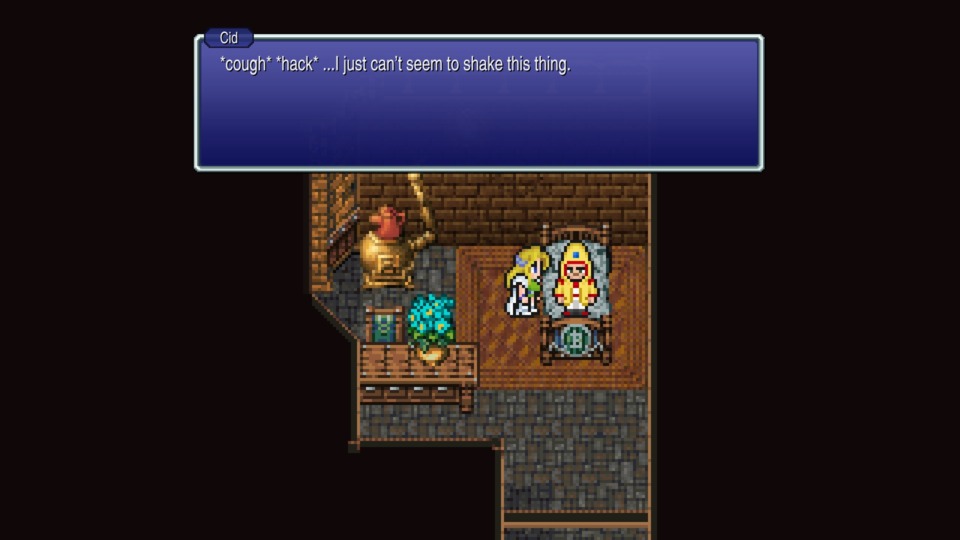
To make up for the fact that I spent most of the last section lecturing semi-negatively about the reveal of the World of Ruin, I want to discuss a scene I love more than the average Final Fantasy VI fan! That's right; I want to talk about catching fish for Cid! I know some people actively hate the sequence on Solitary Island because they feel like it is an anti-climactic follow-up to everything that takes place on the Floating Continent. To those people, I say "hogwash!" The Returners FAILED, and the best way to make that crystal clear to the player is to make you attend to the basic needs of one of your characters. In this case, you control Celes in a physically compromised state and struggle to help her feed her adopted father. Going from trying to avert a world crisis to working to meet the foundational blocks of Maslow's hierarchy of needs is a spectacular fall from grace. Some might contend the physical process of catching the fish and dragging them to Cid is monotonous and mechanically unsatisfying. I would counter that's the fucking point because Cid dying is the more logical outcome given the circumstances.
I'll be honest, the one part about Solitary Island I'm not too fond of stems from the ending in which you save Cid. Cid revealing that he made a raft for Celes to use to get to civilization has always felt like a cheap deus ex machina. That is why I think the ending in which Cid dies and Celes attempts suicide by jumping off a cliff is the more impactful outcome. It gives Celes a strong sense of why she needs to complete the adventure she started in the World of Balance and better communicates her frame of mind. Regardless of what you think, the game uses the subsequent two cities after Solitary Island to show the nigh omnipotence of Kefka. While at Tzen, beams of energy set buildings on fire and toast innocent civilians. Luckily, it is also here where Celes meets up with Sabin, and if you want to know, I was jumping with glee. As I hinted at during the last episode, I tend to make the mistake of under-leveling Celes partly because she spends much of the World of Balance away from your party. Dragging her ass to Tzen is no fucking fun because the random encounters at the World of Ruin are notably more brutal than the ones in the World of Balance. The World of Ruin doesn't fuck around and is NOT programmed to account for you only having one player character for a brief moment. To add insult to injury, you can't grind on the Solitary Island before entering the main continents as the enemies there immediately die because they are afflicted with Sap. So, if your version of Celes is three to five levels behind the pace, you will have a miserable time during the bit inside the collapsing house.
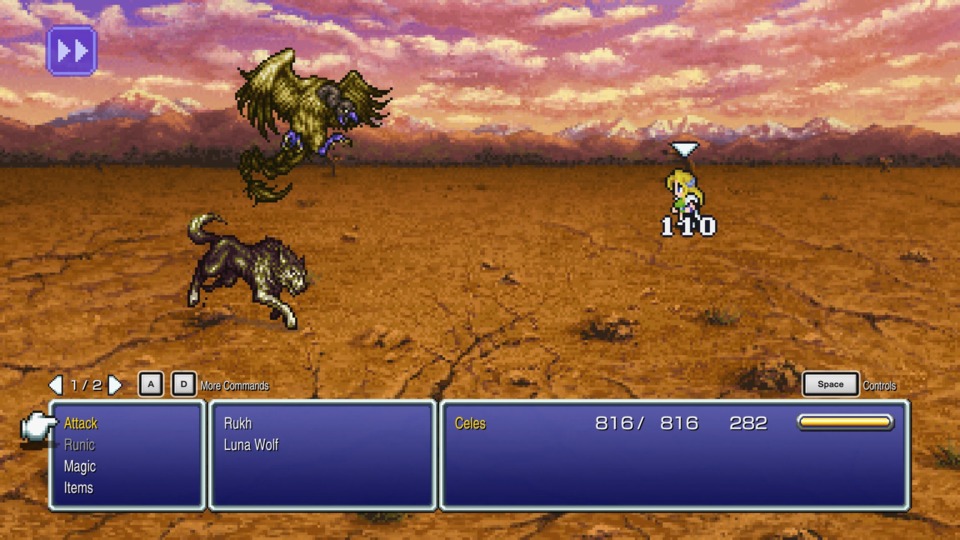
However, at least with Sabin, you have some crowd control options even if the two characters don't have a substantial assortment of Esper abilities. I appreciate how Sabin is your only "easy" party member to recruit. Every subsequent character requires you to explore their life after you fail to stop Kefka. Some of these explorations are brisker than others, with a handful requiring the player to engage in repeat prodding and long-form quests. Edgar is a fun middle ground wherein the game wants you to see how everyone copes and responds to failure without too much fuss. Initially, it appears as if he's masquerading as a different person and no longer wishes to keep up with his duties as a king. You find him commanding a merry group of pirates under a new name and assume he's developed a persona to move on from the past. However, eventually, he announces he's secretly defeating criminal operations from within when it seems like you have him figured out. Part of me wishes the game committed to Edgar needing to develop a facade to come to terms with the wasteland of the World of Ruin, but discovering he's Final Fantasy VI's version of Batman isn't all that bad either.
Along the way, you explore villages from the World of Balance and immediately register the dire situation of the characters. Once bustling town squares now only have half the number of NPCs as before, and everyone has something to relay about how they survived and what toll the last year has taken on them. Later, there are examples of the NPCs showcasing flashbacks to better times, like when a bartender laments his present lack of customers and recalls when people were lining up to have a good time at his establishment. The new filter on the overworld gives the World of Ruin a sickly orange hue as if the planet is still ablaze. It is worth repeating that the Pixel Remaster neuters the punch here a bit with an overbearing amount of brightness that removes much of the World of Ruin's moodier shadows. Nonetheless, the introduction of the World of Ruin provides a solid first impression regardless of how you play Final Fantasy VI. I know when Avengers: Endgame came out, everyone and their grandmother wrote about the similarities between that film and Final Fantasy VI. Nevertheless, there's something timeless about the World of Ruin and people needing to get by on a dead planet.
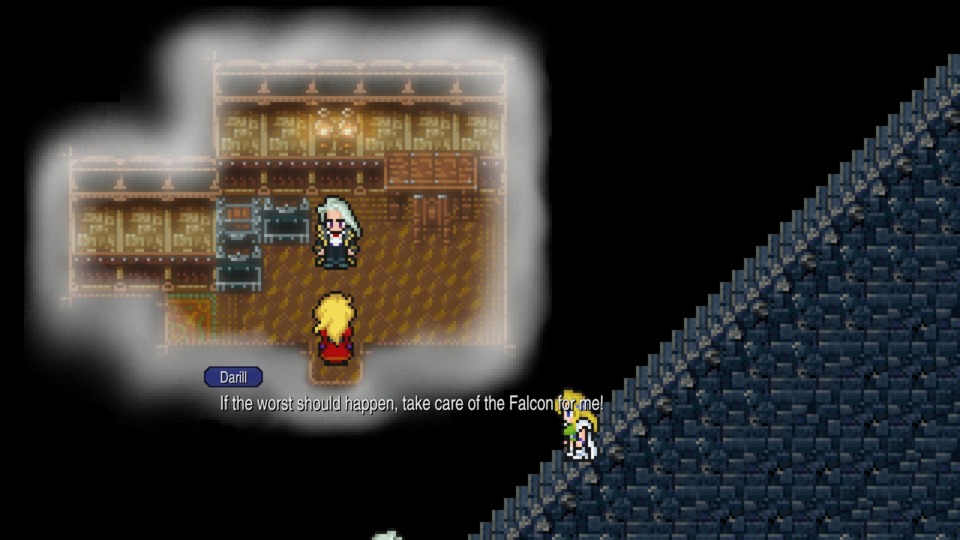
The decision to have Setzer be one of your four "required" characters is understandable, considering he's the pilot. However, everything the game does with Setzer sucks complete and total shit. Setzer's "Boo hoo, I'm a victim of grief just like the rest of you!" act is something I have never accepted. Just because his girlfriend died many years ago doesn't excuse the fact he kidnaps women. I understand that Celes, Sabin, and Edgar chastize Setzer for turning to alcohol as a coping mechanism. However, it sucks that their efforts amount to joking about it and humorously calling him a sack of shit. Darril's Tomb is also the proverbial "Undead Dungeon" where you fight a bunch of ghouls, ghosts, and Malboros that inflict you with every status effect under the sun. It's annoying to play and made worse thanks to the MANY flashbacks where you get more of Setzer's unconvincing sob story. Whether intended or not, I think there's something incredibly shitty about a male character putting his foot down and saying, "I NEED ME A WOMAN TO COMPLETE MY LIFE!" and that's the parting message with Setzer. There's also no denying how Setzer always feels like a cheaper, less charming facsimile of other members of your party. His philandering ways in the World of Balance echo Edgar's, and the conclusion of Darril's Tomb, wherein the completion of the dungeon absolves Setzer of his grief, is done much better with Locke's quest.
Part 14: Because I Love You, I Played Every Single Side Quest In Final Fantasy VI
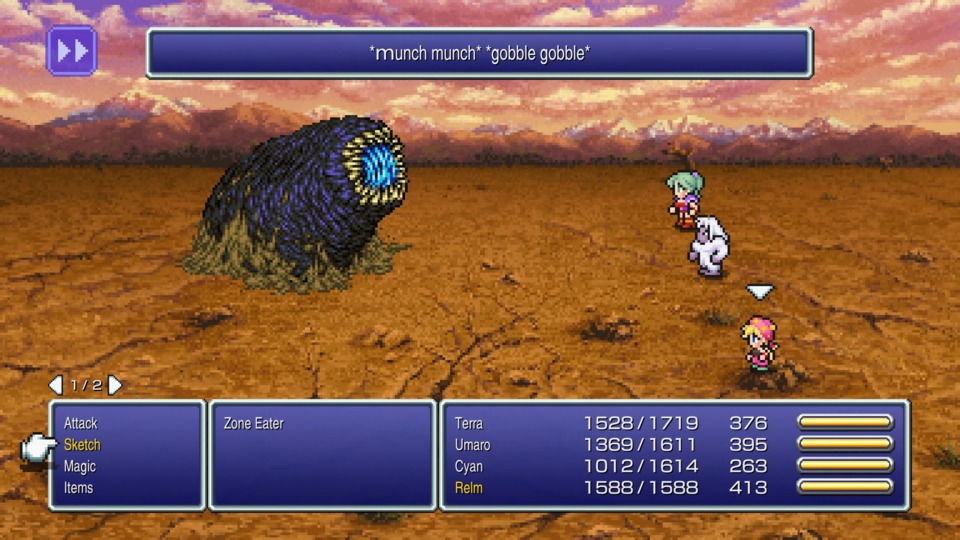
Whenever I reach the "point of no return" in a Final Fantasy game, I spend excessive time completing optional quests. Final Fantasy VI is no different, but I want to clarify one point. While recruiting the rest of your party members is technically optional, I think the opposite is true in execution. I know there are ways to complete the game with the default four characters. However, outside the context of speedrunning, you honestly owe it to yourself to get everyone back on the team. The storylines and plot threads associated with some of your former teammates are among the best in the game, and having the whole cast adds a lot to the epilogue. However, as we will review shortly, the characters and Final Fantasy VI's end-game content are shockingly uneven. Some characters, towns, and environments get a ton of love, whereas others get one-off scenes that add very little to the overarching themes of the narrative.
So, I did everything and want to share my "recommendations" for anyone who might play Final Fantasy VI for the first time. I'm sticking with the character recruitment missions for this episode and will do the other ancillary tasks next time. To assist in my reviews, I will evaluate the game's side quests based on five categories:
- Time, Physical, & Emotional Investment (1-10): How long does the side quest take to complete? A score of 1 suggests completion is almost instantaneous, whereas a score of 10 indicates the side quest is as exhaustive as finishing the entire game.
- Gameplay/Loot Utility (1-10): Are the mechanical and gameplay rewards for this side quest worth it compared to the average time investment? A score of 1 or less suggests the rewards are trash or nothing, whereas a score of 10 indicates the item or items provided are overpowered or strongly recommended.
- Storytelling & Worldbuilding Relevancy (1-10): Is this a pointless fetch quest for a random hat, or does it add something to the story? A score of 1 means there is little character or story relevance. In contrast, a score of 10 indicates the side quest is as or possibly more narratively essential than some or many mainline quest missions.
- Difficulty (1-10): How hard is the mission to complete for the everyday person or someone playing this game for the first time? A score of 1 means no barriers to finishing the side quest exists. In contrast, a score of 10 means the side quest either has major dexterity-based accessibility issues OR conflicts, encounters, or boss battles associated with the side quest pose a significant hindrance that requires extensive planning or grinding on the part of the player.
- Discoverability (1-10): How much of a pain is it to get to and start this quest? Likewise, what's it like traveling to all its associated locations and places? A score of 1 means the side quest is on a well-worn path or right in front of the player. A score of 10 means we have reached Knights of the Round levels of ridiculous backtracking and wandering around in circles.
Oh, one quick note. I will review Cyan's dream sequence in the final blog because that sequence comes AFTER you succeed at his recruitment mission.
Getting Sabin's Ultimate Ability
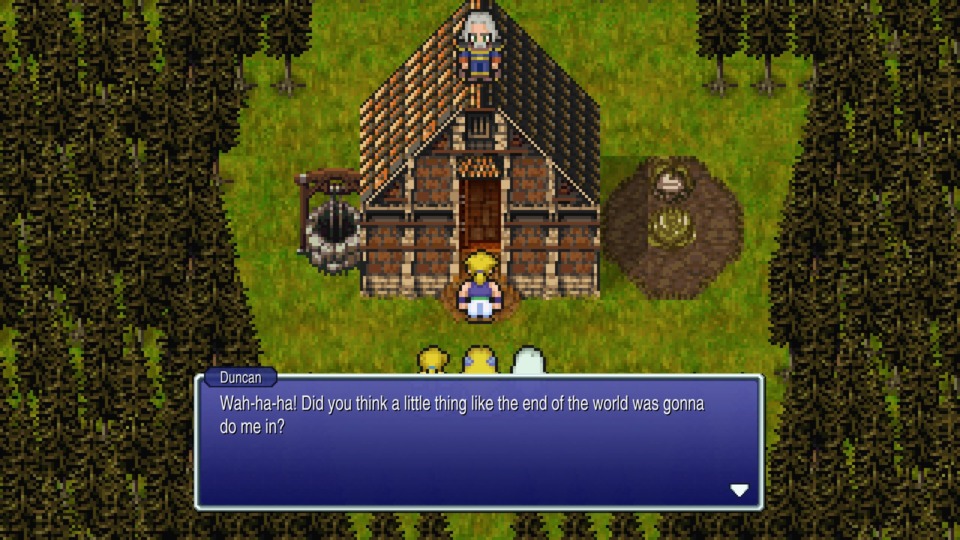
Premise: If you have been paying attention to Sabin's backstory, then you know he once trained to be a martial artist under the tutelage of a master named "Duncan." If you return to the cabin next to Narshe and Mt. Kolts with Sabin in your party, he will duel Duncan on top of the house. After their brawl, Sabin will unlock his final Blitz, the Phantom Rush (i.e., Bum Rush).
- Time, Physical, & Emotional Investment: 1/10 - No leveling is required to complete this quest. While it seems like Duncan and Sabin should have a one-on-one boss battle, that's not the case. All you need to do is remember to have Sabin in your rotation, and the game does the rest of the work for you.
- Gameplay/Loot Utility: 7/10 - Phantom Rush is an outstanding ability as it inflicts massive damage and is non-elemental. If Sabin is decently leveled, it quickly outpaces Flare and is only a few steps behind Ultima. However, it is a complicated command to perform, and if you are playing anything BUT the Pixel Remaster, it takes a lot of practice to get right. Also, during the late game, you should start to wean the characters from their abilities in favor of Magicite.
- Storytelling & Worldbuilding Relevancy: 2/10 - This scene is concise to the point where I consider it a massive disappointment. Sabin's relationships with his brother and Gau during the World of Balance were significant parts of his developing characterization, but neither fully forms in the World of Ruin. Also, Duncan is a nothing burger.
- Difficulty: 1/10 - It is a non-interactable cutscene.
- Discoverability: 2/10 - I guess one could argue knowing to go to the cabin is tricky. However, it's next to Narshe, a location you will visit at least once if you intend to make your party whole, and it's not as if the cabin is hard to find.
Recommendation: Do it, but only because it is so low-stakes that you might as well. Also, if you enjoy using Sabin, getting his ultimate ability is a must.
Gau's Sidequests
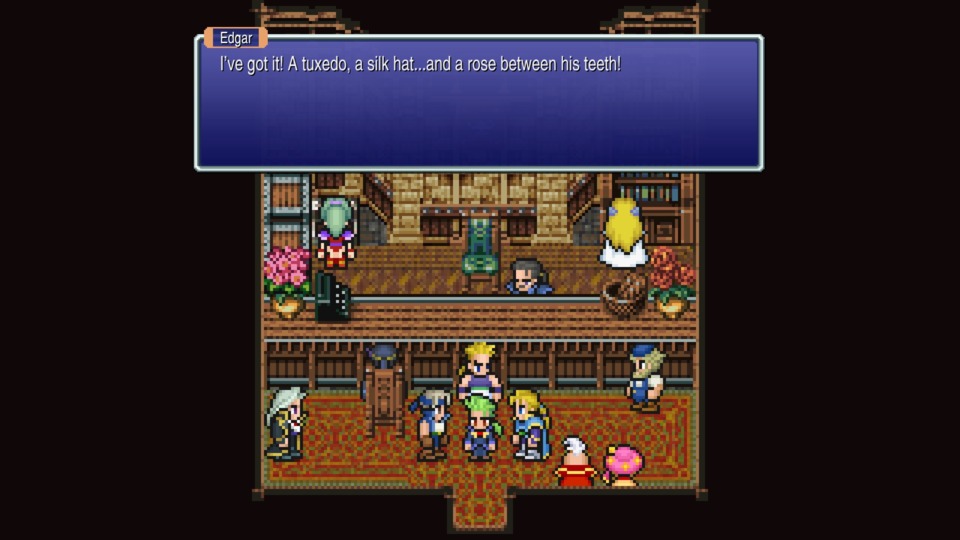
Premise: Gau has two distinct parts to his characterization during the World of Ruin. First, you need to get the Falcon and then park it on the Veldt. If you have three or fewer party members, you can encounter Gau, and he rejoins the party without a single protest. The second part involves reuniting Gau with his father. To accomplish this task, you must locate a home north of Doma and east of Nikeah. A cutscene will play when you enter the building with Sabin and Gau in your party.
- Time, Physical, & Emotional Investment: 2/10 - Like Sabin's cutscene, you do not need to worry about collecting trinkets or having characters leveled up to a certain point. However, I'll give this a point more than Sabin because getting Gau to spawn on the Veldt can take some time.
- Gameplay/Loot Utility: 5/10 - I'll give half credit because the first part of the quest adds Gau to your party. For the second part, surprisingly, there are no physical or material rewards for reuniting him with his father. Gau doesn't gain a locket his deceased mother once wore, nor does he gain a new powerful Rage ability. This sequence is all about character development.
- Storytelling & Worldbuilding Relevancy: 6/10 - I find the cutscene involving the party dressing up Gau to be supremely satisfying. While you can complete this sidequest at any point, I think it is essential to do it at the end or at least until you have your entire party back. That way, you can watch all the fun ways the characters play off each other. Also, the conclusion of Gau's scene with his father wherein he thanks Sabin is incredibly sentimental. It does not compare to some of the other character arcs in the World of Ruin, but that doesn't prevent it from being a fun, heartwarming moment where the characters get together and shoot the shit. I honestly think the game needs more moments like these.
- Difficulty: 2/10 - Reuniting Gau with his father is a non-interactable cutscene. Finding him on the Veldt can draw some gnarly random encounters, but nothing out of the ordinary.
- Discoverability: 4/10 - I have to ding the game slightly in this regard. It's easy to forget this house exists because you only encounter it during Sabin's route during the game's first act. It also doesn't help that it is tucked away in an easy-to-miss corner of the map, and you need TWO specific characters in your party to initiate the starting cutscene.
Recommendation: This is 100% worth it, but again, wait until you get the entire party before initiating it so you can maximize the storytelling.
Cyan's Recruitment Sidequest
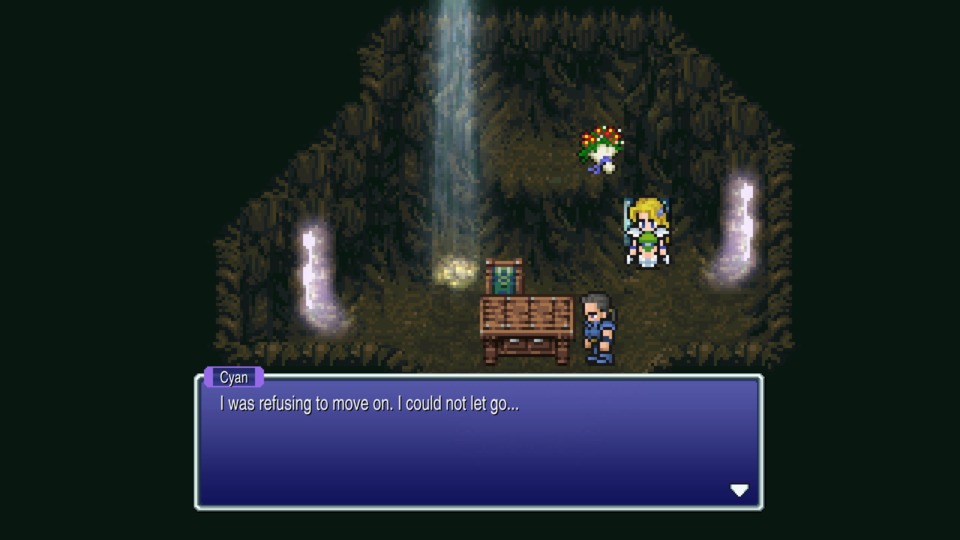
Premise: The minute you finish things off with Setzer, your characters will find a pigeon with a note that has handwriting that matches Cyan's. The characters remark that the pigeon is heading for Maranda, a city you probably want to visit because an old lady there will identify where every old landmark and town from before is in the World of Ruin. When you find the letter's intended recipient, she states that the pigeons come from Zozo. When you head to Zozo, you discover it is as much a mess as before, but you'll eventually find a rusted-shut door to an apartment that can only be pried open by using oil from a merchant. Upon entering the building, you see Cyan, but he runs to the nearby mountains. You eventually chase after him and find his abode inside a cave and convince him to rejoin the party.
- Time, Physical, & Emotional Investment: 6/10 - At face value, you must explore three distinct locations (i.e., Maranda, Zozo, and Mt. Zozo) to recruit Cyan. I know you can skip the first of these, but you might as well go to Maranda because there are some excellent items and weapons there, and it's nice to reconnect with an old environment. The Zozo and Mt. Zozo parts of this mission are what almost kills it for me. Both are dungeons with a freakishly high encounter rate, and as we will talk about shortly, this recruitment mission is tough to complete when the game presents it to you.
- Gameplay/Loot Utility: 7/10 - Getting Cyan back is clutch. If you take the time to level him up, Cyan is a workhorse. I'll give him an extra point over Gau only because the late-game armor and swords he can pick up are ridiculous.
- Storytelling & Worldbuilding Relevancy: 6/10 - I love what the game does with Cyan as a character. Since his introduction in the World of Balance, the game has presented him as a "man out of time." His plot threads in the World of Ruin continue that. Furthermore, I enjoy the sentimentality of his Cyrano de Bergerac impersonation. Unfortunately, if you failed to start or finish the letter-sending quest in the World of Balance, the conclusion here might seem sudden or out of place. Also, the real payoff to Cyan doesn't happen until you return to Doma Castle and initiate his dream sequence.
- Difficulty: 6/10 - If you follow the game's recommendations and attempt to recruit Cyan after raising the Falcon, you might find yourself in a bind. I highly doubt a party featuring Celes, Sabin, Edgar, and Setzer is anyone's "A-Team." Additionally, some random encounters are absolute ball busters if you work with a sub-optimal party composition, making this a taxing ordeal. Delaying this mission until you have a few more characters in your rotation seems like a better course of action, but that doesn't change the serpentine dungeon design on the mountain being any less annoying.
- Discoverability: 2/10 - The game tells you how to start this mission right after you wrap up your shit with Setzer. There are extra steps, but even then, it tells you exactly what you need to do. The only curveball is maybe the rusted door, but even that's resolved quickly.
Recommendation: Yes, you should complete this mission.
Terra's Recruitment Mission
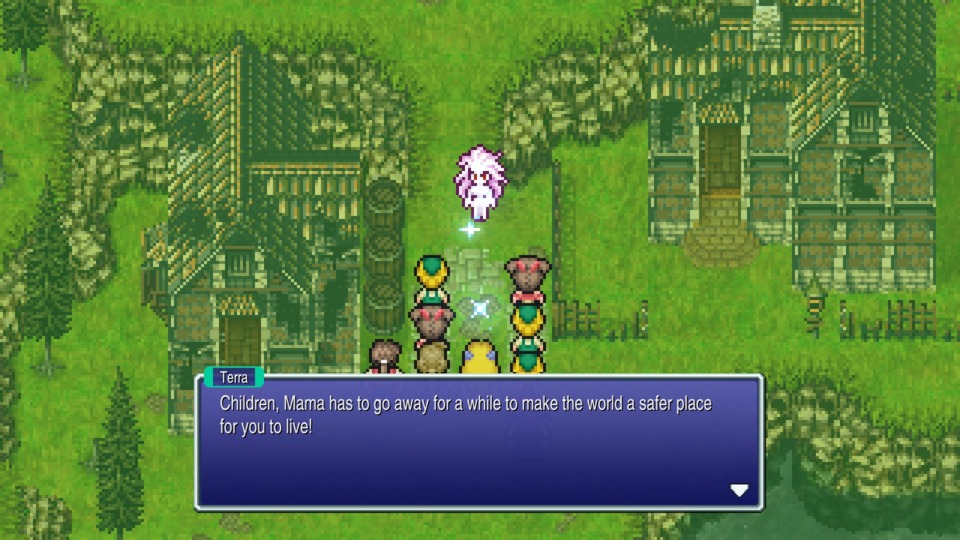
Premise: Terra is in Mobliz running an orphanage for children who lost their parents when Kefka brought forth the World of Ruin. When you first encounter her, she welcomes you but refuses to rejoin the party citing her obligations to protect the children around her. If you talk to her after raising the Falcon, you can press her further about the issue, but your dialogue is interrupted by a monster named Humbaba. After Terra intervenes in your battle against this beast as an Esper, she realizes she needs to join the fight against Kefka to learn more about herself.
- Time, Physical, & Emotional Investment: 2/10 - Mobliz is on the main continent, and you can even trigger the first part of your interactions with Terra before you get the Falcon. Because the town was a central focal point during the story, I cannot imagine anyone skipping it or struggling to find it. Likewise, everything you do here is appropriately paced, including your battles against Humbaba.
- Gameplay/Loot Utility: 10/10 -You get Terra back.What more needs to be said? Oh, and the Fenrir Magicite is incredibly useful. Terra is one of the strongest magic-casters in the game and the most lethal if you understand how to take advantage of her Esper form. Fenrir, on the hand, has the Banish ability, which can be handy on a few bosses, and the +30%MP buff it gives upon level-ups is enormous.
- Storytelling & Worldbuilding Relevancy: 7/10 - I enjoy what the game does with Terra at the orphanage. It's almost flawless for wrapping up her tragic backstory. I know some people dislike how her characterization errs ever so closely to the "frailty of women" trope Squaresoft was incredibly guilty of during this era. However, knowing Terra to be someone who never had a childhood, I couldn't help but feel emotional in watching her help children live their bests lives.
- Difficulty: 4/10 - The battles against Humbaba can be groan-inducing if you don't know they are coming. The first battle is a forced loss, and the second is only slightly above the random encounters you have experienced. The third battle is supremely annoying as Humbaba can blow away up to two party members. This move can prove meddlesome if you are trying to beat him with a top-heavy team. However, eventually, Terra arrives to bail you out as an Esper. Mercifully, the boss is weak to poison-based attacks, which Terra should have on tap.
- Discoverability: 3/10 - When you first explore Mobliz, finding the orphanage's hideout can be tricky. However, with the theme of the World of Ruin being "Hey, what if you saw how every city from the World of Balance is doing," it's hard to imagine missing Terra because you didn't know to go to Mobliz and check out every abandoned building.
Recommendation: Yes, you should do this mission. What the fuck are you doing if you don't recruit Terra?
Shadow's Recruitment Mission & Dreams
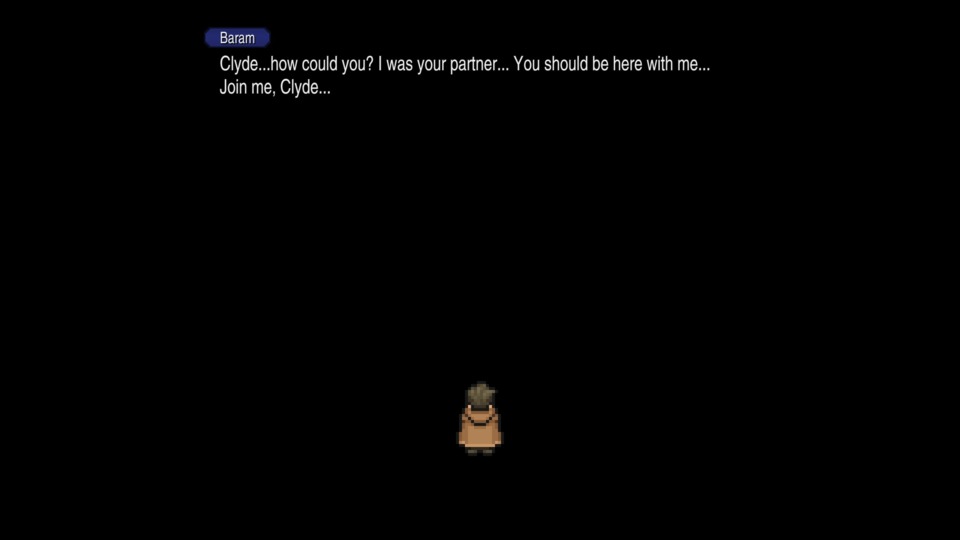
Premise: Shadow is somewhat in the same camp as Gau. To recruit him, you need to track him down to a specific location and then talk to him. The difference here is that he will only appear if you remember to wait for him when leaving the Floating Continent. Where things get murky is when you start to delve into his backstory. If you have Shadow in your party and stay in an inn, there's a chance a cutscene will play that shows the life and times of a man named Clyde. Clyde starts as a petty thief, and things come to a head when he tries to rob a train with his pal, Baram. Clyde ends up in Thamasa, where a woman attends to his injuries from the train robbery. In the final flashback, you see Shadow leaving Thamasa with Interceptor and leaving behind a baby girl.
- Time, Physical, & Emotional Investment: 4/10 - I will be honest. I have never authentically triggered all of Shadow's cutscenes in a normal playthrough. I always forget they exist, and by the time I remember, I'm scrambling about the World of Ruin and seeing how many of them I can trigger before fighting Kefka. It's weird. I can manage to trigger three cutscenes in a row, but I have never been able to watch the last one. That's part of the reason why I can't rank this too low. You need to go out of your way to have Shadow in your party AND use different inns, preferably at various intervals in the story.
- Gameplay/Loot Utility: 8/10 - Getting Shadow is "nice." At this stage of the game, you can start stocking up on shit for him to throw. Shadow hits like a truck with the appropriate equipment, and I can't forget to mention the various high-tier ninja-only equipment in the World of Ruin. Beyond that, his backstory is another cutscene-heavy sequence but takes multiple attempts to get the complete picture.
- Storytelling & Worldbuilding Relevancy: 6/10 - I think some people rank Shadow high in their rankings of Final Fantasy VI's characters because of his "coolness factor." I like how his music is unlike any you hear in the rest of the game. However, people often embellish what the game does with Shadow and instead graft their headcanons. It's fun to note that Final Fantasy VI leaves things ambiguous. Shadow being Relm's father, was not made canonical until AFTER Final Fantasy VI's release.
- Difficulty: 4/10 - Recruiting Shadow requires you to return to a cave on the Veldt. There's a decent number of random encounters to deal with, but the good news is that the enemies in the cave are weak to fire. As you follow Interceptor, you eventually run into a Behemoth boss, which is also mercifully vulnerable to fire. Annoyingly, however, the boss can revive itself, thus causing you to need to fight it twice.
- Discoverability: 5/10 - If you visit Thamasa, the citizens there will mention a ninja that "set out to defeat a horrible monster." Finding the next cave where Shadow resides isn't that hard, considering it's a previous environment from the World of Balance. What throws this category for a loop is getting all of his cutscenes. The game isn't particularly clear about how to trigger them or if you need to do something special to guarantee them.
Recommendation: Sure! Shadow is a good character when you decide to fight Kefka, especially if you feel your party is under-leveled or underprepared. His throw ability can make up for a lot because you probably have a ton of junk by this point. Just don't expect a ton from his cutscenes.
Recruiting Gogo
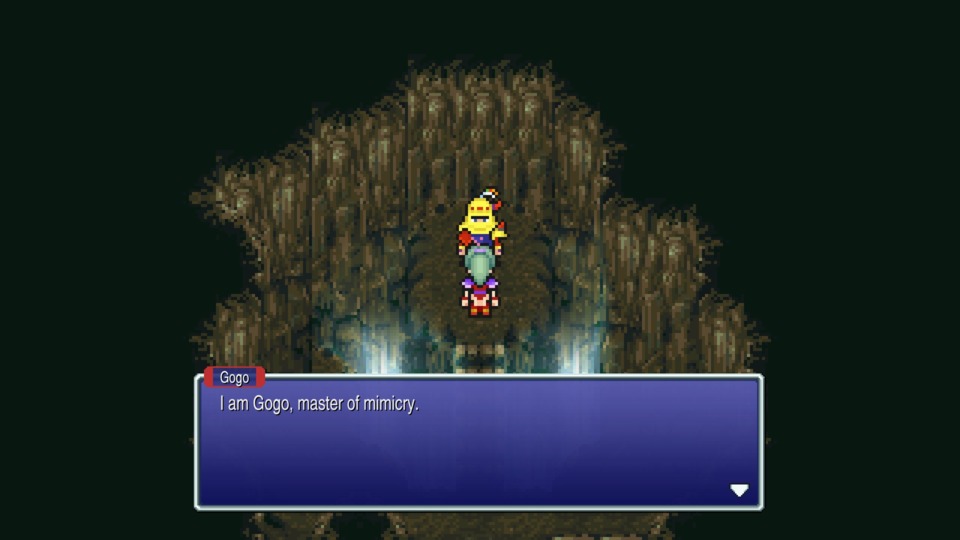
Premise: To get Gogo, you'll need to head to a triangular island near the upper-right portion of the map. You need to park the Falcon on this island and continue spawning random encounters until you find the Zone Eater. The trick is to allow the monster to eat your characters. Allowing this action to happen is the only way to access the secret dungeon in its belly. While there, you can encounter other trapped adventurers and plenty of goodies (i.e., the Genji Armor). When you reach the final chamber, you discover the legendary "Master of Mimicry," and he promptly joins your party.
- Time, Physical, & Emotional Investment: 6/10 - I will discuss this more in the "Difficulty" section, but the Zone Eater dungeon is not for the faint of heart. There's a lot of stuff in and about the dungeon that can get you in trouble. Between the heavy-hitting samurai enemies and platforming section, I found this to be one of the most challenging end-game dungeons short of The Cultists' Tower. Parts of this level are downright exhausting to play in a single sitting, and it does not help that it goes on a bit too long.
- Gameplay/Loot Utility: 5/10 - Gogo is an impossibly tricky character to assess. He cannot be taught magic via the Magicite System and instead needs to rely on his Mimic ability. If you can plan this out appropriately, he can do some decent damage. However, the random number goddess doesn't always love you, and if the characters get out of order, that makes Gogo's main gimmick a hindrance rather than an asset. That said, the Zone Eater dungeon is worth exploring, even if you don't like Gogo. There's a lot of high-tier loot worth catching if you can stay alive as you explore it.
- Storytelling & Worldbuilding Relevancy: 2/10 - Gogo is a non-factor in the story. He has a fun scene during the game's epilogue if you have him, but other than that, he adds almost nothing to the narrative. I will give him one point more than Umaro only because of the location you recruit him. There's some compelling worldbuilding inside the belly of the Zone Eater.
- Difficulty: 8/10 - Once you get past the first two screens, the level starts spawning samurai and ninjas that can easily wipe your party if you are unprepared. Also, there's a platforming section to this environment, which controls like hot garbage. If you fall off a platform, you have to start from scratch, and there's another section where you need to avoid falling rocks that is equally punishing. If you allow a stone to squish your party, you get an immediate "Game Over" and need to restart from your most recent save. There's a lot of cheap bullshit in this dungeon that makes it a complete pain in the ass.
- Discoverability: 7/10 - Not only is the starting location in the middle of nowhere but knowing the trick with the Zone Eater is a definite curveball. Once you enter the Zone Eater, the subsequent dungeon is labyrinthine to a fault. With no light at the end of the tunnel, it isn't easy knowing you can get Gogo in the first place.
Recommendation:Maybe. If you have a strong "Gotta Catch 'Em All!" sentiment, go for it. Getting Gogo is a decent gear check before you attempt some of the more challenging late-game content. If you can breeze through this part of the game, you are ready for almost everything else. However, if you feel like this part of the game is making you miserable, feel free to skip it.
Recruiting Mog & Collecting Valigarmanda (i.e., Triotoch)
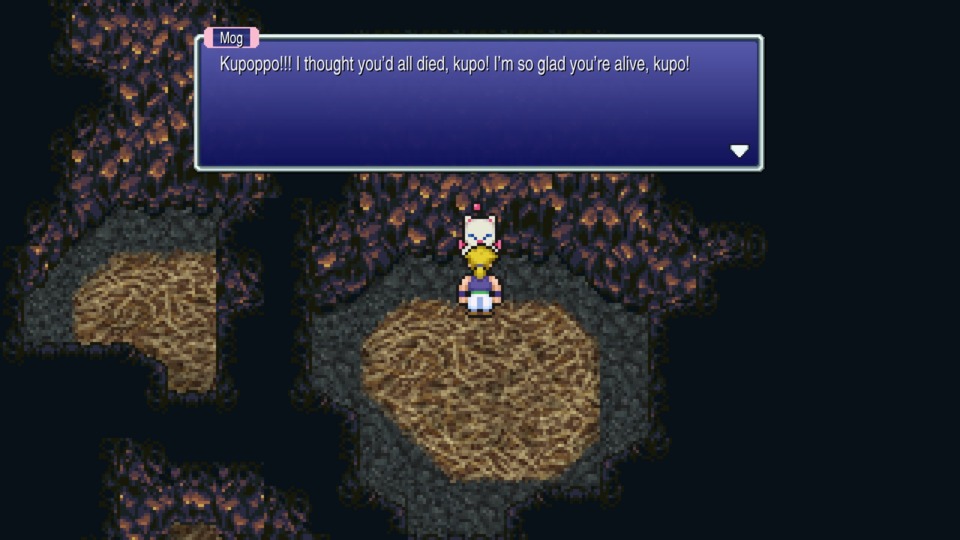
Premise: If you forget to pick up Mog at the World of Balance, they can still join your party in the World of Ruin. Either way, head over to Narshe and make your way to the secret entrance you used to get out of Narshe during the game's first chapter. You'll find Mog, and he will join the party without much protest. However, he mentions a yeti in the upper caves and reminds the player of the frozen Esper from earlier. To save time, I'll lop getting Valigarmanda (i.e., Triotoch) in with Mog. The Esper challenges the player to prove they are worthy, and when they do, they relay a legend before turning into Magicite.
- Time, Physical, & Emotional Investment: 6/10 - I wasn't a fan of the floorplan of the Narshe Caves the first time, and I am not a fan of it here. I know the game wants you to go to the frozen Esper you saw at the start of the game, but it has been HOURS since you last saw it! Narshe doesn't have a yellowish World of Ruin filter that makes its pixels harder to parse out, but it still is tough to tell where you need to go in the caves. As a result, I always forget how to get to Valigarmanda and need to look it up in a guide. Other than that, it's the same dungeon you have seen countless times with the same encounter rate but with more formidable enemies. I didn't find it too demanding.
- Gameplay/Loot Utility: 8/10 - Mog gets plenty of praise for two reasons. First, their dance mechanic has its uses, and if you remember to pick up the "Water Dance" ability during the World of Balance, there are a lot of random encounters that will go down fairly quickly. The second and far more critical reason to pick up Mog is to utilize its Moogle Charm, which disables random encounters. That makes Mog a HUGE asset even if you put in zero time to level up their stats. Also, the Valigarmanda Esper is among the most useful because it teaches the best elemental spells and gives a nice Magic stat boost upon level-ups.
- Storytelling & Worldbuilding Relevancy: 4/10 - I can't say Mog adds nothing to the story, but his best story moments are in the World of Balance. The actual storytelling comes from your interactions with Valigarmanda. While brief, it is nice seeing things come full circle with something that was the focal point of the game's first act.
- Difficulty: 4/10 - The encounters at Narshe are more demanding in the World of Ruin than in the World of Balance. However, they should be manageable as long as you have been doing some world exploration or grinding. Valigarmanda is no slouch, but it has an easy out as it is weak to fire.
- Discoverability: 4/10 - As I said before, I find navigating the Narshe Caves unfun. Beyond that, I cannot imagine anyone having a hard time finding Narshe or not feeling like they should explore the town and its nearby cave in a normal playthrough. All you need to do is keep moving forward, and the game will do the rest. If you elected to skip Mog during the World of Balance, he might not immediately come to mind when you get the party back together. But even then, that's a low barrier to entry compared to the other party members.
Recommendation: Sure! For the Moogle Charm alone, Mog is a must for me. Being able to turn off random encounters makes some of the latter portions of the game (i.e., Locke's dungeon and the Cultists' Tower) far more tolerable. Returning to Narshe is also fun and worthwhile beyond picking up Mog.
Getting Umaro
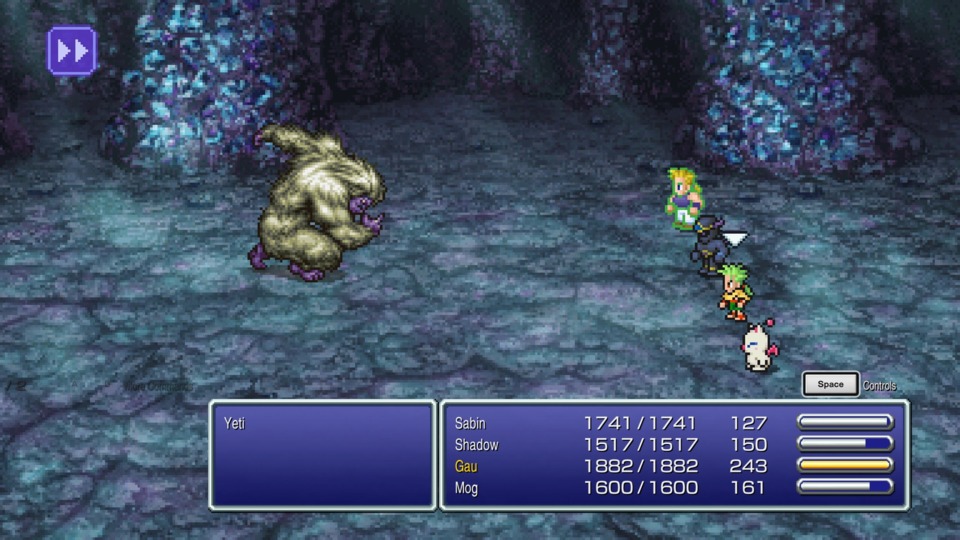
Premise: After you pick up Mog and beat Valigarmanda, the Moogle will mention that a friend of his can be found in a different part of the Narshe Caves. It is important to note that you need Mog in your party if you wish to recruit Umaro. When you enter a new opening, you will eventually run into an abominable snowman that immediately attacks you. Luckily the monster is weak to fire and goes down rather quickly. When you knock out the yeti, Mog chastises the beast, and Umaro promptly joins the fray.
- Time, Physical, & Emotional Investment: 5/10 - The part of the Narshe caves that leads to Umaro has some annoying pitfalls, but other than that, it is a straightforward route. When the battle starts, Umaro goes down relatively quickly because he's weak to fire, and that's one of the most manageable elements to level up to its highest form.
- Gameplay/Loot Utility: 2/10 - Umaro is a terrible character in most circumstances. In fact, he's a massive liability if he's in your party. Not only can he not equip armor, but he also is unable to use Espers. But the cherry on top is that Umaro is a berserker, and you have zero control over his actions. You can give him an orb that adds a snow spell to his repertoire, but that's about it. That said, Umaro is immune to the Cultists' Tower's restrictions prohibiting physical attacks, and his limited move-set makes him an asset in the Colosseum.
- Storytelling & Worldbuilding Relevancy: 1/10 - Umaro adds almost nothing to the story. Like Gogo, Umaro has a fun moment during the game's epilogue if you have him. But that's about it.
- Difficulty: 3/10 - As I said earlier, Umaro is weak to fire, making him an easy target. Admittedly, he hits hard, but as long as you fight him with four relatively prepared characters, his boss encounter should be cake.
- Discoverability: 2/10 - The door to Umaro opens the second you pick up Mog. The only reason why I'm not giving this a one is because navigating the Narshe Caves sucks.
Recommendation:Ehhhhhhhhhhhhhhhhhh! You might as well, considering he's about three steps removed from where you pick up Mog. But don't worry about feeling like you need to use him. Umaro is complete dogshit.
Recruiting Relm
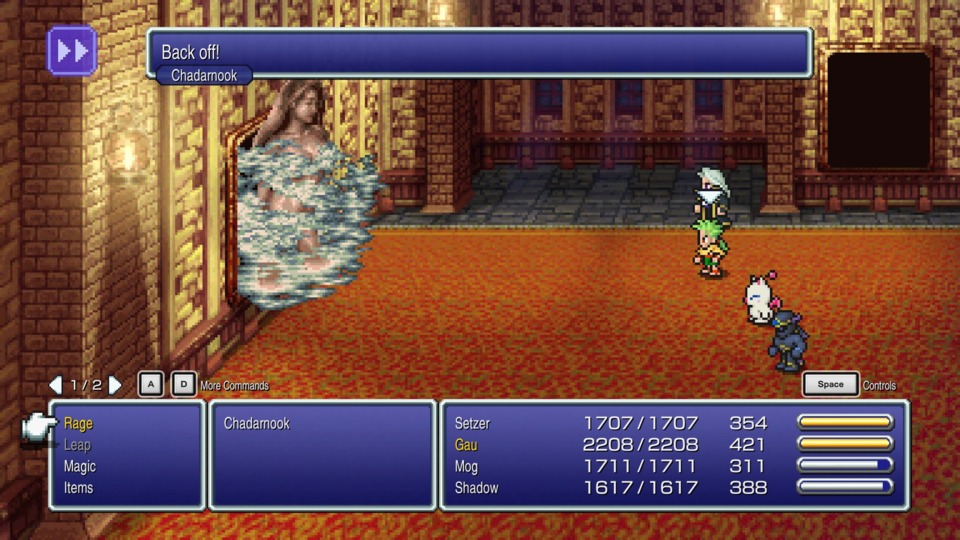
Premise: Remember when you had a minor in your party? Every Final Fantasy ensemble needs at least one child party member! To get Relm back, head to Jidoor and find the large mansion at the top. When you enter it, you will notice something is amiss. When your party destroys a painting that comes alive, they find a secret passageway that leads to a haunted portion of the mansion. In the final chamber, they find Relm painting a portrait under the watchful eyes of a possessed Owzer, who owns the estate. The painting comes to life, and you must defeat it to gain Relm and a piece of Magicite.
- Time, Physical, & Emotional Investment: 5/10 - I think Owzer's Mansion goes on far longer than it should. There's some fun regarding the initial premise of the mansion being haunted, but it wears thin rather quickly. The location is a bit of a gimmick and has a lot of random encounters that reflect that. I usually have Mog in my party with the Moogle Charm enabled when exploring the mansion. Even with those random encounters turned off, the mansion actively seeks pleasure in making you confused about your location.
- Gameplay/Loot Utility: 6/10 - I'm not going to turn down a full-fledged party member, but I don't particularly enjoy using Relm. Her special move is too situational, and her low defense stat means she's always getting KO-ed when I did not prepare her Relics sufficiently for the end of the game. Nonetheless, she has her uses with her insane MP pool and is a strong secondary candidate for teaching Ultima after Terra. Lakshmi, however, is clutch. It introduces a bevy of high-tier healing magic, albeit at a slower rate, to Phoenix. Combined with Phoenix, you can wean yourself off designated healers and have everyone capable of party-wide white magic.
- Storytelling & Worldbuilding Relevancy: 5/10 - Like Mog, I'm not going to sit here and say Relm doesn't add anything to the story. However, as I will discuss in the final section of this blog, her character arc feels like a self-contained vignette with no grounding in the main plot. It's a decent story, especially if Shadow is alive during your playthrough. Additionally, it is vital to note Relm is needed before you can get Strago's character mission. Still, even Final Fantasy VI stans will be hard-pressed to claim Relm's characterization is as beneficial to the game's overarching themes as Cyan or Locke's character arcs.
- Difficulty: 5/10 - As I said, I usually disable the random encounters when I get to Owzer's Mansion. There's one encounter that is a toughie wherein the enemy throws an almost endless supply of elemental scrolls at the party. As for the bosses, and there are two, both are one-trick-ponies. "Still Life" is a living canvas and is weak to fire, and Chadarnook employs ye olde trope of having one version of itself you can attack and a different version you need to block continuously. Neither are too tough to handle but require some strategy in mind.
- Discoverability: 2/10 - When you are in the World of Balance, you encounter Owzer's Mansion repeatedly and think there's bound to be something important there. The game continually teases you until you reach the World of Ruin that something big will happen in the mansion. With that in mind, I don't think the breadcrumb trail leading to Relm and Lakshmi is perfectly cogent either.
Recommendation: Sure. This will sound harsh, but I think getting the Esper is more important than Relm. Relm adds some fun flavor to the story, especially when it is time to complete Stargo's character arc, but even that's not critical. I know Relm is a Magic tank with one of the highest pools of raw MP in the game, but her special is highly situation, and her alternative is only helpful if you want to take the time to collect Blue Magic for Strago.
Strago's Sidequests
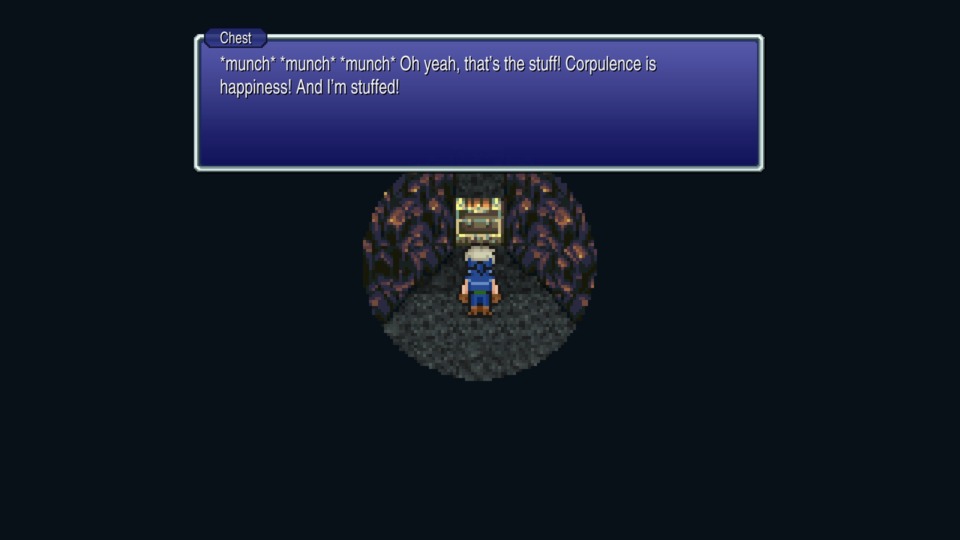
Premise: Strago's quests break into two parts, the first being incredibly quick. To recruit the old geezer, you must find the Cultists' Tower and convince him to abandon the cult. After he joins the party, remember to have him AND Relm in the same rotation when you revisit Thamasa. Doing so will trigger a cutscene with Gungho, whom you may or may not have encountered at the World of Balance. Gungho speaks of a legendary monster and begs for Strago to defeat it. However, the beast in question is in a newly formed dungeon called "Ebot's Rock." After some coral collecting, they encounter Hidon, defeat it, and watch a scene where Strago reminisces with his old friend.
- Time, Physical, & Emotional Investment: 6/10 - Okay, Ebot's Rock is unlike any dungeon in the game in that it is a mystery dungeon. The format is randomized to a degree. Your objective is to collect enough coral from treasure chests to feed an anthropomorphic chest at the entrance leading to Hidon. If you are not careful or take an inefficient route, you might end up short in that regard. If that happens, you must do the entire dungeon again. That sucks, and if you don't utilize Mog, this dungeon is populated by many undead enemies that enjoy inflicting your characters with the Zombie status effect. Even with random encounters turned off, it's still a tiresome dungeon.
- Gameplay/Loot Utility: 5/10 - You get Strago and his ultimate ability. Due to the coral mechanic, there's no loot in the dungeon, and defeating Hidon does not provide an Esper. Still, getting Strago back and better than ever is better than nothing. Grand Delta is FINE as a last resort, but it doesn't compare to most of the end-game magic spells you should be teaching Strago at this point.
- Storytelling & Worldbuilding Relevancy: 8/10 - You know what? I'll cop out and admit I enjoyed the scene at the end with Strago and Gungho. It's a touching scene that ends with a nice message about keeping your elderly family members in mind. Likewise, the interplay between Strago and Relm is, as always, excellent. Seeing more of their chemistry and relationship is worth the price of entry alone.
- Difficulty: 3/10 - "Wait a minute ZombiePie, didn't you just say you find the design of this dungeon annoying and time-consuming?" Now, hear me out for this one. Yes, this dungeon is annoying, and some enemies are gnarly. However, because most of your foes here are undead, you can instantly beat everything using Phoenix Downs or revival spells. That includes Hidon, but you'll want to hold off on that until it performs Grand Delta. With such an easy out, it's hard to rank Ebot's Rock exceptionally high.
- Discoverability: 4/10 - Navigating Ebot's Rock is the worst part of Strago's mission. You can memorize the pattern or look up the floorplan on a guide. Nonetheless, that doesn't stop you from needing to run around searching for boxes of coral whose amounts are randomized.
Recommendation: Sure! But if your time is limited and you don't use Strago all that much, I think it is reasonable to pick him up and leave things at that. The conclusion of his character arc is quaint, with some heart-warming moments, but there are bigger fish to fry with your party. Speaking of which...
Locke's Sidequest
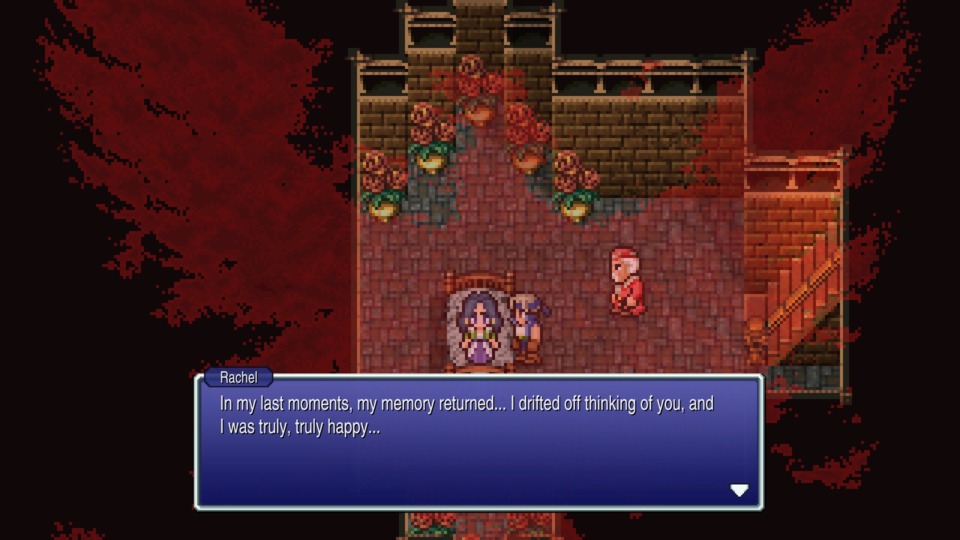
Premise:We now transition to what I consider the second-best character storyline in the entire game. Suppose you brought Locke to Kohlingen while at the World of Balance, then you know he has his former love, Rachel, in suspended animation. One of his driving motivations for joining the Returners is so he can explore the world for a legendary treasure that can reverse death. There are a few hints about where this might be, including a random portrait in Owzer's mansion, but eventually, you end up in the Phoenix Cave. While here, you need to create two parties that alternate in flicking switches and progressing further into the cave. Ultimately, you'll find a cracked and worn Magicite version of the Phoenix Esper. Locke will take this to Rachel, but it will only revive her for a few seconds before she merges with Pheonix and reforms the Magicite.
- Time, Physical, & Emotional Investment: 7/10 - Navigating the Phoenix Cave is a chore. The random encounters are no slouch, with a handful happy to inflict you with adverse status effects. Because you need to divide your party into two groups, you can't rely on Mog to avoid random encounters. Also, the backtracking and lever flicking isn't fun and becomes wearisome as soon as it introduces itself. The dungeon also has a platforming bit where you need to pay attention to moving walkways or otherwise risk falling into a pool of lava. In other words, this dungeon finds plenty of ways to make your life shitty, even if you have taken the time to make your characters more than decent at combat.
- Gameplay/Loot Utility: 10/10 - All my grousing aside, the Phoenix Cave is 100% worth completing. Locke is a good character with a lot of utility thanks to his Steal command. Some optional bosses have fantastic loot if you can manage to get Locke early and can steal from them. Likewise, Phoenix is one of the best Espers in the entire game. It teaches the best revival and healing magic in the game, which makes up for the fact that it has no level-up bonuses. Curaga, Arise, and Reraise are all CRITICAL late-game abilities at least one of your rotational pieces should have in their repertoire. Finally, with Locke, you can also steal treasure from some of the locked buildings in Narshe!
- Storytelling & Worldbuilding Relevancy: 10/10 - Locke's story arc is one of the best in the game. I understand it's problematic, considering it revolves around him putting a woman in a comatose state without her permission. However, the game recognizes this point and allows you to render a personal determination if Locke is in the right or not. The ending wherein Rachel pleads for Locke to look to the present instead of the past spoke to me. When she implored Locke to realize some people love him in the present as much as he loved her, I couldn't help but get a little emotional. With Final Fantasy stories the subject of many recurring jokes on the internet, it speaks volumes that this one quest in a nigh thirty-year-old video game speaks louder and truer about the human experience than 90% of what modern Square-Enix outputs.
- Difficulty: 7/10 - As I said before, the lava portion of the dungeon is not easy. One way the game enjoys screwing you over is by mixing enemies with the opposite elemental weaknesses. There's at least one random encounter possibility where half the enemies are weak to fire but absorb ice, and the other half is the opposite. The good news is that there isn't a final boss battle at the end of the dungeon. When you reach the Magicite, you immediately transition to a cutscene that requires no player input.
- Discoverability: 6/10 - Exploring the Pheonix Cave is exclusive to the World of Ruin. Likewise, your hints about its existence are few and far between. That said, when you start using the Falcon, it is odd that there is a star-shaped mountain jutting from the ground. The real issue then is navigating the cave, which is a colossal pain in the ass. Switching between two parties prepares you for what you'll eventually have to do at Kefka's Tower, but it sucks there as well. There are dead-ends and horrible monsters happy to end your session in failure. It's exhausting, but at least it is worth it.
Recommendation:Getting Locke is a requirement by my metrics. Locke is a good character; the game tells a fantastic story with him; the rewards for completing his mission are impressive. In other words, do this shit!
Part 15: The World Of Balance Is Better Than The World Of Ruin
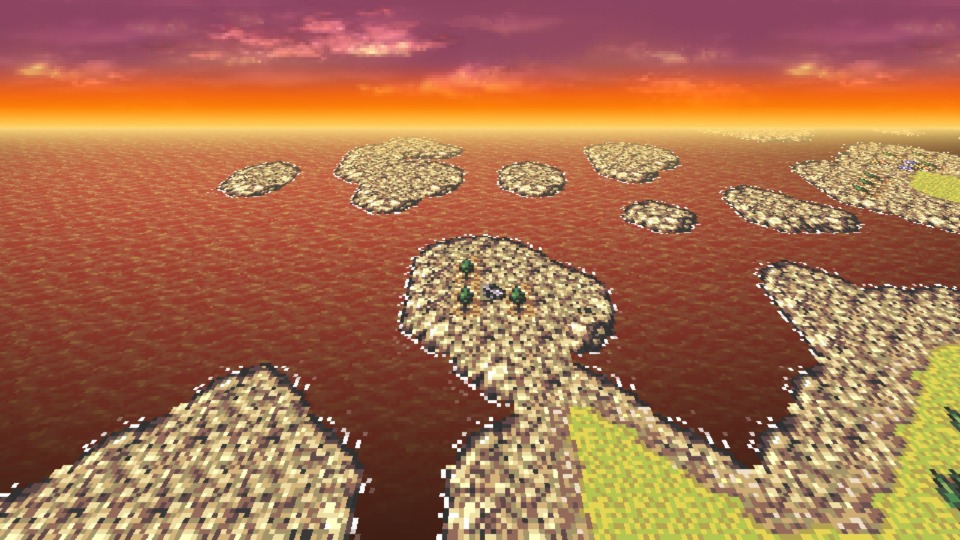
I understand the above chapter title is bound to throw some of you in a tizzy, but I want to clarify a few points before I lay out my thesis. First, I'm not saying the World of Ruin is "bad." I was and still am enamored by the sheer gall that the mad lads behind Final Fantasy VI commit to, and the atmosphere of the World of Ruin is some of the best in the game. Second, I agree that the character arcs at the World of Ruin are highly satisfying and sometimes on par with what you experience in the main plot. I'm not going to sit here and lie to you that Cyan and Locke's character missions didn't make me feel something. Third, I know some people LOVE the free-form and open-world nature of the World of Ruin and feel it organically inspires the player to explore their surroundings and pick up on context clues to "get the team back together." Finally, there's no denying that the World of Ruin feels like a hand-crafted sandbox for the members of the party you need to recruit. I do not reject any of this. Instead, I think there's something far less compelling about the World of Ruin's grind-heavy and "leave no stone unturned" structure than the snappiness and blow-for-blow nature of the World of Balance's construction.
There's something far more thrilling, at least to me, about the pacing in the World of Balance. At the World of Balance, whenever you complete a level or set piece, the characters converse and immediately identify where they need to go next. That linear structure might rub some people the wrong way, but I think it fits the ensemble nature of the cast faultlessly. Each character gets their introduction during a backdrop explicitly connected to the main story rather than during a siloed sequence. There's equity with how much the World of Balance divides its time among your party members, and I wish that were present in the World of Ruin. No one character overstays their welcome in the World of Balance because there's more afoot than just them. And as you can see in my reviews, some of the longer character sequences in the World of Ruin are simply self-indulgent and make characters that get less look worse. The top-heavy nature of the character arcs is one thing, but the bigger problem is how the main plot stops dead in its tracks and depending on how much time you invest in the optional quests, you could be forgiven for forgetting about the story's finer details. The simple process of exploring the overworld and getting to locations takes time, and it adds up the more you play.
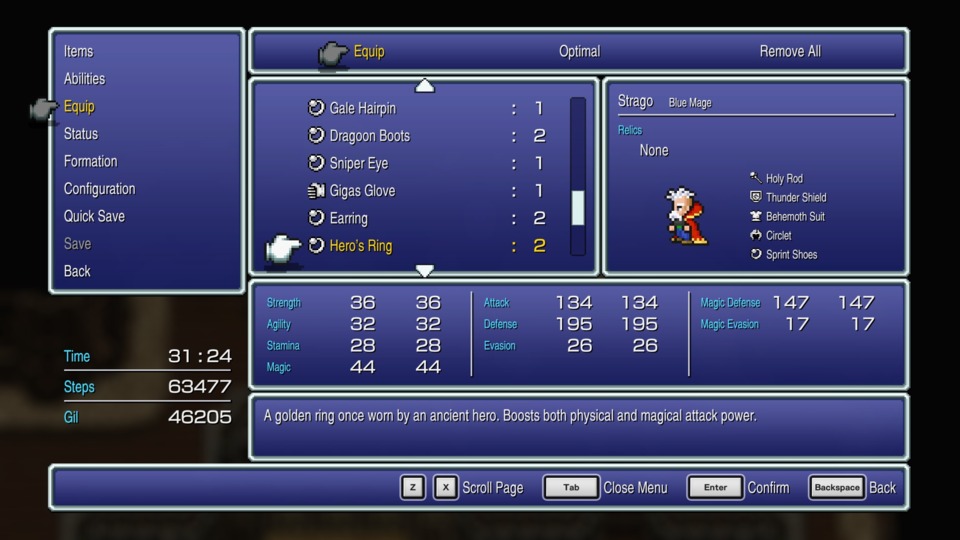
Each character's level and sequence feeling like a self-contained vignette is the best and worst part of the structure of the World of Ruin. You better understand who they are and what they have been hiding through these vignettes. However, chasing after everyone with little guidance is a burdensome load the game doesn't sufficiently frontload. There's also no more frustrating feeling than taking the time to travel to a far corner of the known world and discover your only reward is a short cutscene or quick back-and-forth dialogue sequence. Worse, the main plot involving the Warring Triads and Kefka falls to the wayside. In fact, during my first playthrough, I completely forgot what the Warring Triads were until I started to fight them in Kefka's Tower. The game does a terrible job of building up their mythos and backstory. Speaking of Kefka's Tower, I again have to bring up the topic of how much harder the World of Ruin is compared to the World of Balance. Some of the dungeons and random encounters you run into feel unfair or rely on tired and true old-school RPG design. The bowels of the Zone Eater have hard-hitting ninjas that can wipe your party if you are not careful. The trippy sequence in Cyan's subconscious is visually and narrative impressive, but with no accessible exits, you can end up in a frustrating situation of constantly reloading your progress. Sometimes the simple task of trudging to a dungeon inflicts you with punishing random encounters that employ any number of cheap bullshit. This problem leads us to the inevitability of grinding, and goddamn, you need to do a lot of grinding in the World of Ruin.
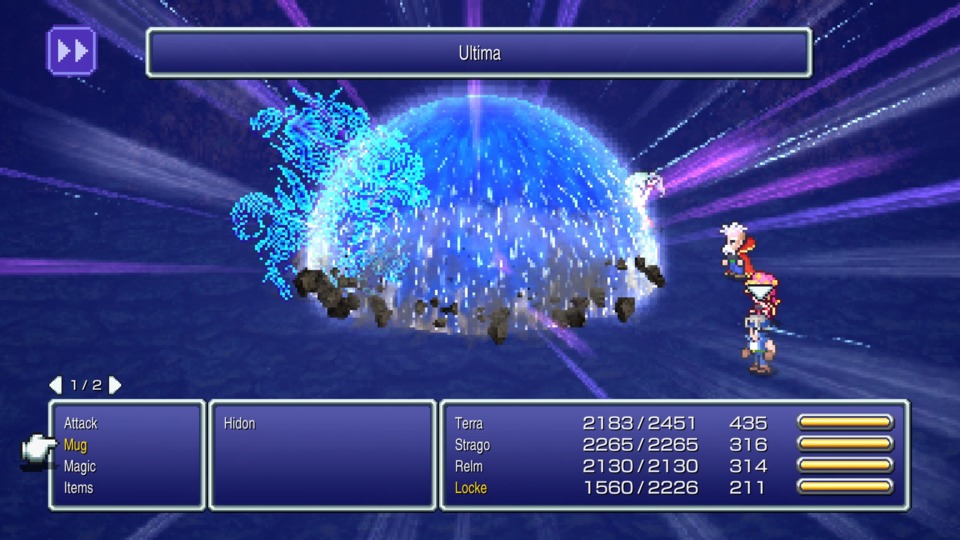
Something about the World of Ruin causes me to burn out when I try to replay Final Fantasy VI. Unless you know the several combat exploits in the game, if you attempt to enter Kefka's Tower the moment it becomes available, it will kick your ass. If you do not try to collect all of the remaining party members like they are Pokémon, the game expects you to park your ass in a dungeon and grind until your characters bridge the level twenty-five or higher mark. The problem is, even when you collect everyone, you still need to do this. Kefka's final castle requires you to split up your party, and as a result, you need to spend time making three well-rounded teams. Completing this task is downright painful if you spent most of your time on the World of Balance with a favored team of four. Trying to get Setzer, Celes, and Strago on par with everyone else fucking sucks no matter which version of Final Fantasy VI you play. The grind-heavy nature of the World of Ruin exacerbates many of the fundamental issues I have with the game's leveling and Magicite Systems. You don't make an army of soldiers with distinct playstyles with the Espers at your disposal. Instead, you make the same one or two types of super soldiers repeatedly, and that repetition becomes tedious after a certain point. Worse, having to constantly fiddle with the Relic and Esper menus when swapping one party for a different one never ceased to drive me up the wall. I felt like setting up a blank slate of four characters on a good day took me about seven to eight minutes. Now, imagine doing that at least twenty to thirty times!
None of what I'm saying here should suggest I think the World of Ruin is a failure. Quite the opposite. It's packed with excellent storytelling, and the game's worldbuilding shines when you get there. However, something always feels "off" whenever I get to the World of Ruin. There are mechanical and narrative structural issues later games in the series would refine and eventually perfect. However, I plan to continue to explore this topic during my final write-up on Final Fantasy VI. Next time you see me publish a blog about Final Fantasy VI, we will discuss the game's ending!
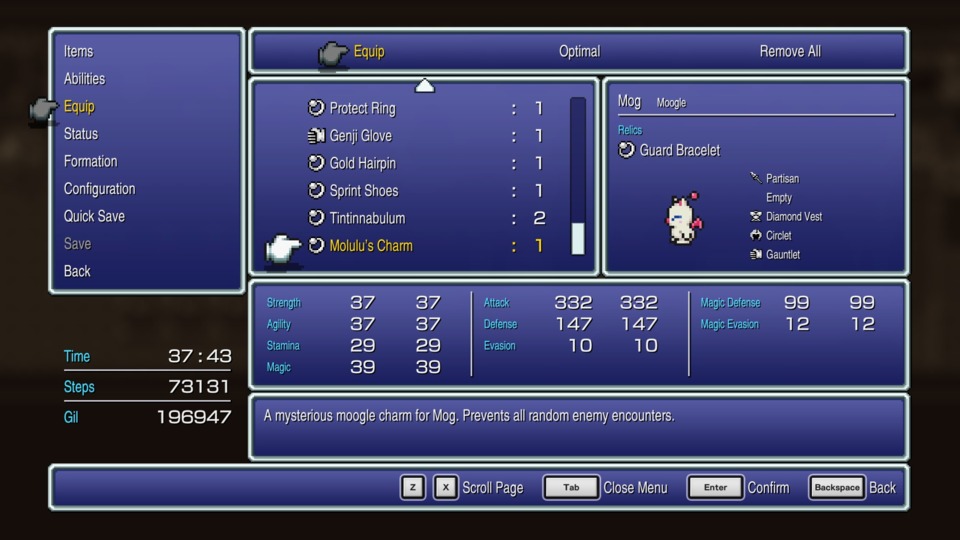
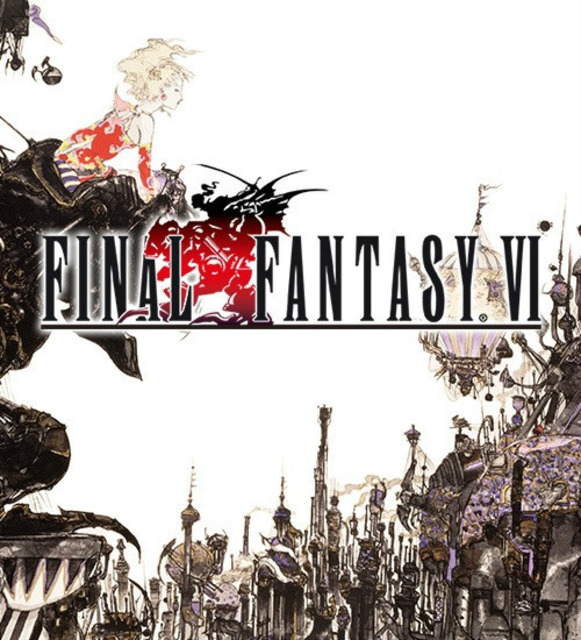
Log in to comment